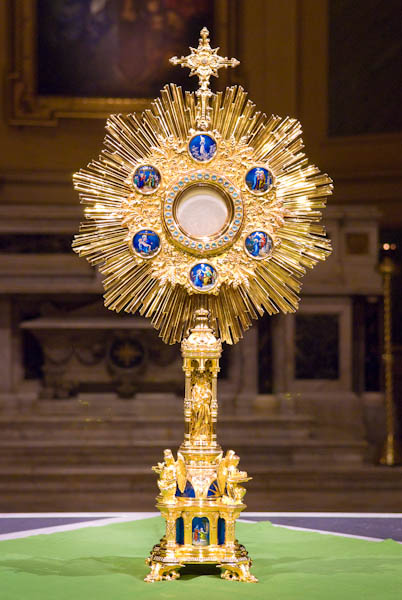
The Feast of Corpus Christi (Latin for Body of Christ), also known as Corpus Domini, is a Latin Rite liturgical solemnity celebrating the tradition and belief in the body and blood of Jesus Christ and his Real Presence in the Eucharist. It emphasizes the joy of the institution of the Eucharist, which was observed on Holy Thursday in the somber atmosphere of the nearness of Good Friday.
In the present Roman Missal, the feast is designated the solemnity of The Most Holy Body and Blood of Christ.[1] It is also celebrated in some Anglican, Lutheran, and Old Catholic Churches that hold similar beliefs regarding the Real Presence.
This year 2015 the Solemnity of the Corpus Christi was celebrated all over the world yesterday June 7, 2015.
The feast is liturgically celebrated on the Thursday after Trinity Sunday or, "where the Solemnity of the Most Holy Body and Blood of Christ is not a holy day of obligation, it is assigned to the Sunday after the Most Holy Trinity as its proper day".[1] At the end of Holy Mass, there is often a procession of the Blessed Sacrament, generally displayed in a monstrance. The procession is followed by Benediction of the Blessed Sacrament. But due to the season of rain the procession is being carried on the last Sunday of the catholic calendar in November proceeding the first Sunday of Advent.
A notable Eucharistic procession is that presided over by the Pope each year in Rome, where it begins at the Archbasilica of St. John Lateran and makes its way to the Basilica of Saint Mary Major, where it concludes with Benediction of the Blessed Sacrament.
The instrument in the hand of Divine Providence was St. Juliana of Mont Cornillon, in Belgium. She was born in 1193 at Retines near Liège. Orphaned at an early age, she was educated by the Augustinian nuns of Mont Cornillon. Here she in time made her religious profession and later became superioress. Intrigues of various kinds several times drove her from her convent. She died 5 April, 1258, at the House of the Cistercian nuns at Fosses, and was buried at Villiers.
Juliana, from her early youth, had a great veneration for the Blessed Sacrament, and always longed for a special feast in its honour. This desire is said to have been increased by a vision of the Church under the appearance of the full moon having one dark spot, which signified the absence of such a solemnity. She made known her ideas to Robert de Thorete, then Bishop of Liège, to the learned Dominican Hugh, later cardinal legate in the Netherlands, and to Jacques Pantaléon, at that time Archdeacon of Liège, afterwards Bishop of Verdun, Patriarch of Jerusalem, and finally Pope Urban IV. Bishop Robert was favourably impressed, and, since bishops as yet had the right of ordering feasts for their dioceses, he called a synod in 1246 and ordered the celebration to be held in the following year, also, that a monk named John should write the Office for the occasion. The decree is preserved in Binterim (Denkwürdigkeiten, V, 1, 276), together with parts of the Office.
Bishop Robert did not live to see the execution of his order, for he died 16 October, 1246; but the feast was celebrated for the first time by the canons of St. Martin at Liège. Jacques Pantaléon became pope 29 August, 1261. The recluse Eve, with whom Juliana had spent some time, and who was also a fervent adorer of the Holy Eucharist, now urged Henry of Guelders, Bishop of Liège, to request the pope to extend the celebration to the entire world. Urban IV, always an admirer of the feast, published the Bull "Transiturus" (8 September, 1264), in which, after having extolled the love of Our Saviour as expressed in the Holy Eucharist, he ordered the annual celebration of Corpus Christi in the Thursday next after Trinity Sunday, at the same time granting many indulgences to the faithful for the attendance at Mass and at the Office. This Office, composed at the request of the pope by the Angelic Doctor St. Thomas Aquinas, is one of the most beautiful in the Roman Breviary and has been admired even by Protestants.
The death of Pope Urban IV (2 October, 1264), shortly after the publication of the decree, somewhat impeded the spread of the festival. Clement V again took the matter in hand and, at the General Council of Vienne (1311), once more ordered the adoption of the feast. He published a new decree which embodied that of Urban IV. John XXII, successor of Clement V, urged its observance.
Neither decree speaks of the theophoric procession as a feature of the celebration. This procession, already held in some places, was endowed with indulgences by Popes Martin V and Eugene IV.
The feast had been accepted in 1306 at Cologne; Worms adopted it in 1315; Strasburg in 1316. In England it was introduced from Belgium between 1320 and 1325. In the United States and some other countries the solemnity is held on the Sunday after Trinity.
In the Greek Church the feast of Corpus Christi is known in the calendars of the Syrians, Armenians, Copts, Melchites, and the Ruthenians of Galicia, Calabria, and Sicily.
See photos of how the procession looks....



No comments:
Post a Comment